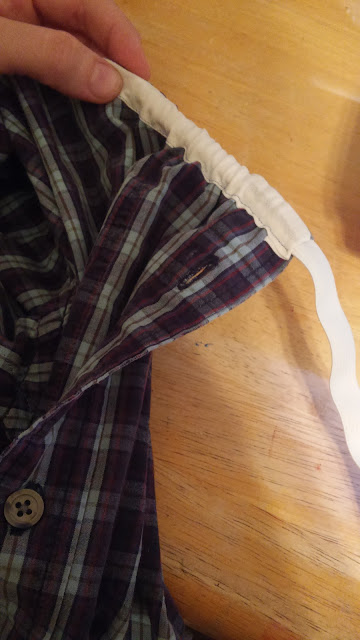Yep, I refashioned another men's shirt. Remember how I mentioned in the last post that my mom really liked the tunic I made my sister and she wanted one too? Well, I decided to make her one. Not having a suitable shirt to turn into a tunic for her, I decided to got to a thrift store to find one. I came home with 2 shirts, one to make her a tunic top from, and this short sleeved, not too huge, white one.
It's a linen rayon blend and just about the softest thing you ever felt. That combined with the fact it was only $1 meant I had to bring it home. It would make a great shirt for my mom, if I ever figured out what sort of a shirt to make from it.
I brought it home and showed it to my mom and sister. Like I did, they loved the softness of it. I commented that I wasn't sure what sort of shirt I would make my mom from it, and my sister immediately had a suggestion.
"How about the Esme shirt?" she said.
"Perfect!" I decided. So my mom found her Sew Liberated Esme Top pattern, and I got to work. I had less than two days before The Refashioners 2015 ended, and I wanted to get this done for that.
I cut the back of the shirt from the front of the shirt, the front from the back, and the sleeves from the sleeves. There was just enough fabric!
The pleats on the back of the shirt lined up perfectly with the new shoulder straps. So I left the original pleats in as a fun design feature, a way to retain as many of the original shirt features as possible.
I also kept the original hem, I just had to open it up at the edges to sew the side seams. Then I resewed the hem at the sides.
The sleeves I feminized, thanks to my mom's suggestion, by making a casing and adding a drawstring.
I lined the yoke, and made the back facing, from some red and white striped cotton. It was left over from a sundress I made my sister at the beginning of the summer. All the original shirt buttons are on the back of the new shirt, so I used some buttons left over from another shirt refashion for the front of this shirt.
The shirt came together pretty easily. I sewed most of it in one night, and just had to finish up a few details on it the next morning. I finished it before the end of The Refashioners!
My mom was pretty happy with her new shirt. It was definitely fun to make her something after everything I've made for myself and my sister.
One of my favorite parts of this refashion is the button placket down the back of the shirt. I've been seeing lots of shirts made for The Refashioners with buttons down the back, so it was fun to make my own refashion with that feature.
My dad said my mom was beautiful, and the shirt was too. It's always fun to get his feed back when I make something!
This was a fun refashion all the way around, and I was so pleased to finish it before The Refashioners ends - today! A huge thanks to Portia at Makery for organizing this event. It has stretched my creative boundary, and now I can't see a men's shirt without thinking "what can I turn that into?" More shirt refashions will definitely make an appearance here in the future. After all I've still got this HUGE shirt to turn into a tunic top for my mom.
(and an awesome little brother who surprised us by coming home for the weekend!)
So keep your eyes open for the finished result, and all my other sewing projects that got put on hold due to shirt craziness!





















































